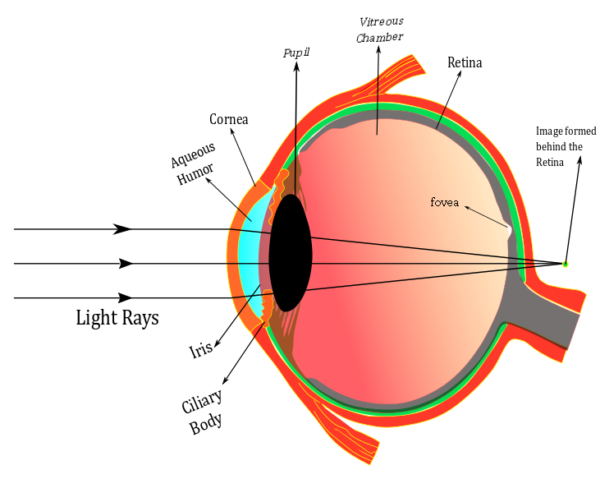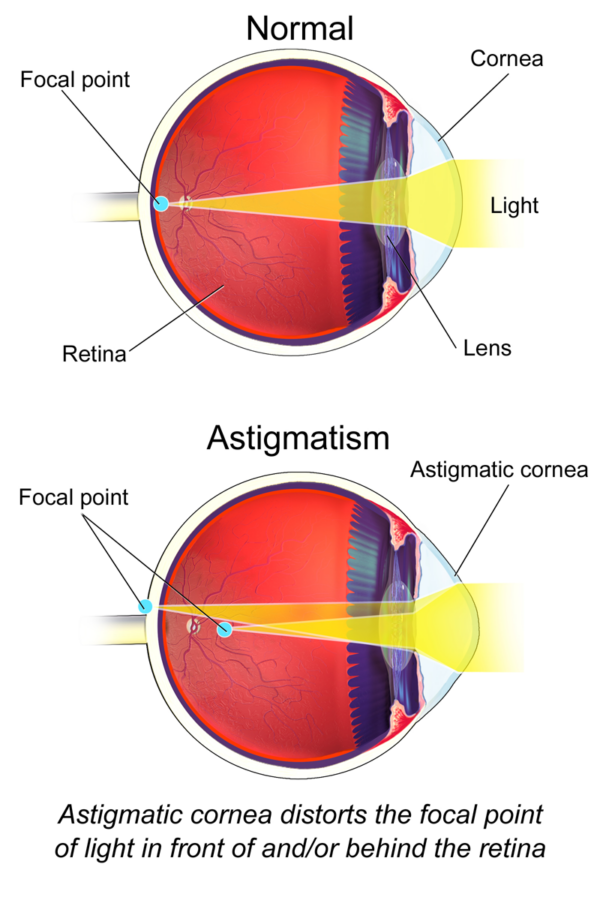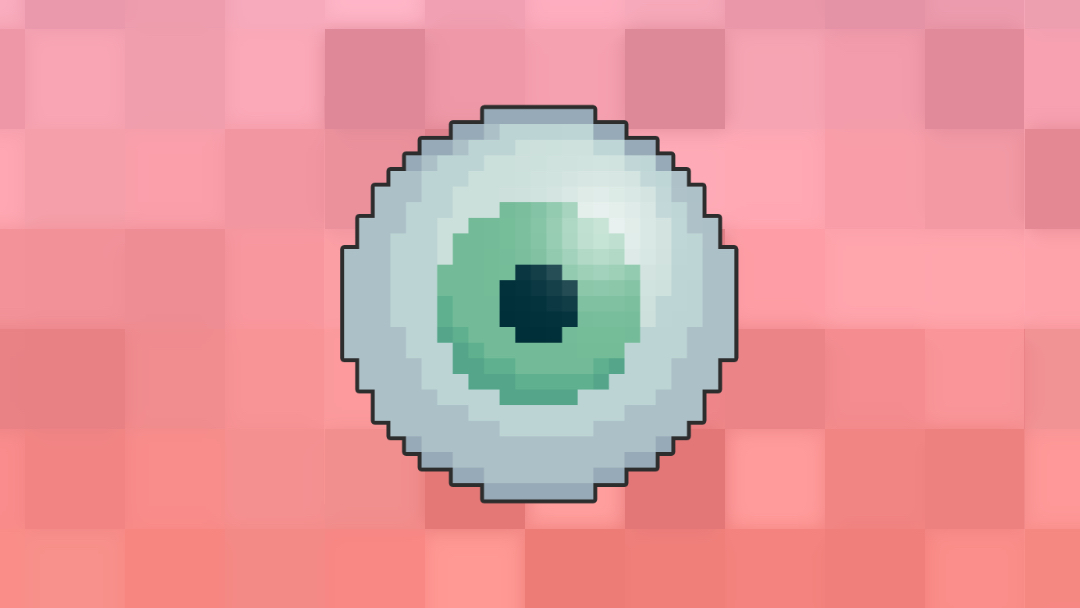- 📖 Geeky Medics OSCE Book
- ⚡ Geeky Medics Bundles
- ✨ 1300+ OSCE Stations
- ✅ OSCE Checklist PDF Booklet
- 🧠 UKMLA AKT Question Bank
- 💊 PSA Question Bank
- 💉 Clinical Skills App
- 🗂️ Flashcard Collections | OSCE, Medicine, Surgery, Anatomy
- 💬 SCA Cases for MRCGP
To be the first to know about our latest videos subscribe to our YouTube channel 🙌
Introduction
Ametropia is an umbrella term for visual disorders caused by abnormalities in the refractive power of the eye leading to blurred vision.
The main components of refraction are the cornea, lens and axial length (anterior-posterior length of the eye). The cornea is responsible for two-thirds of the refraction of the eye, and the lens is responsible for one-third.
In the normal state, also known as emmetropia, light that enters the eye is focussed directly onto the retina. However, in the ametropic eye, this is not the case.
The four main types of ametropia are myopia, hypermetropia, astigmatism and presbyopia. A short or long axial length is the most common reason for myopia and hypermetropia respectively.1
This article intends to provide a basic understanding of ametropia. For more information on the assessment of vision, see the Geeky Medics guide to examination of the eyes and vision.
Myopia
Myopia, also known as near-sightedness, is the state that occurs when the eye is too long, causing light to be focussed in front of the retina.
Myopia can also occur if the eye is too ‘strong’ (i.e. the lens or cornea has too high a focusing power), thus bringing the image forward in front of the retina.
As a result, myopes are able to view objects that are held closely in front of their eyes (due to accommodation), however, anything in the distance will appear blurred.
The prevalence of myopia is variable between ethnic groups, with rates of 20-50% in the United States and up to 80-90% in parts of Asia.2
The aetiology of myopia is multifactorial and still unclear, however, the risk factors associated with myopia include genetic factors, excessive near reading, urbanisation, ambient lighting and nutrition.2

Management
Myopia can be corrected using a concave (minus) lens. This allows the light to hit the retina, thus clarifying the image. Myopia in a patient can also be deduced by looking through their glasses. The lens will minimise the image, so anything seen through those lenses will be minified.

Contact lenses can also be used to correct myopia. This includes both soft contact lenses and hard contact lenses.
LASIK (laser-assisted in situ keratomileusis) is another option for treating myopia. LASIK, or more simply laser eye surgery, corrects myopia by ‘thinning’ the cornea. However, this can only be performed in adults who have stable myopia (i.e. when the prescription is unlikely to change).2, 4
Hypermetropia
Hypermetropia, also known as farsightedness, is the state that occurs when the eye is too short causing light to be focussed behind the retina leading to blurred vision.
This can also be caused if the lens is ‘weaker’ and less able to converge the light rays such that they situate behind the retina and therefore lead to blurring of images.
Hypermetropes tend to have a better visual acuity when viewing objects from afar than from near. The prevalence of hypermetropia is around 10% in the United States.4,5

Management
Hypermetropia can be corrected using a convex (plus) lens. This brings the image forward such that it lies on the retina and can be seen clearly. A hypermetropic patient can also be deduced by looking through their glasses. The lens will magnify the image, so anything seen through those lenses will be larger.
Hypermetropia can also be corrected using soft and hard contact lenses.4, 5
Astigmatism
Astigmatism occurs when the cornea assumes a rugby shape or oval shape as opposed to the normal spherical shape.
This causes the horizontal and vertical axis to differ in steepness. As the cornea is responsible for two-thirds of the refractive power of the eye, a change in the sphericity will lead to a distortion of light during refraction and therefore loss of visual clarity.4

Management
Astigmatism can be corrected using what is known as a cylindrical lens. This can be integrated into glasses, soft contact lenses, and hard contact lenses.
Astigmatism can also be treated using LASIK.4
Presbyopia
Accommodation is the ability of the eye to focus on near objects allowing things brought close to the eye to be seen clearly.
In accommodation, the lens assumes a more globular shape. This effectively increases the power of the eye allowing near objects to be seen.
However, the lens loses this ability with age. From the fourth decade onwards, the lens becomes stiffer and is unable to change shape as easily. This reduces the accommodative ability of the eye, and thus affects the ability for near vision. This phenomenon is known as presbyopia and is an age-related progressive condition that affects everybody.8
Management
Presbyopia can be corrected using glasses for near vision, also known as reading glasses.
If the patient also has an additional ametropia, bifocals or trifocals can also be used. These are glasses that have a near reading portion on the lower half, with their normal prescription lens on the top half.8
Key points
- Ametropia is an umbrella term for visual disorders caused by abnormalities in the refractive power of the eye leading to blurred vision.
- A short or long axial length is the most common reason for myopia and hypermetropia respectively.
- Myopia occurs when the eye is too long, causing light to be focussed in front of the retina.
- Hypermetropia occurs when the eye is too short causing light to be focussed behind the retina leading to blurred vision.
- Astigmatism occurs when the cornea assumes a rugby ball shape or oval shape as opposed to the normal spherical shape.
- Presbyopia occurs following a reduction in the accommodative ability of the eye and is an age-related phenomenon that affects everybody.
Reviewer
Dr Sunil Mamtora
Ophthalmology Registrar
Editor
Dr Chris Jefferies
References
- Root T. Chapter 9: Introduction to Optics. Available from: [LINK]
- American Academy of Ophthalmology. Myopia 2021. Available from: [LINK]
- National Eye Institute NIoH. Myopia diagram. License: [CC BY]
- Alastair K. O. Denniston PIM. Oxford Handbook of Ophthalmology. 2018
- American Academy of Ophthalmology. Hyperopia 2015. Available from: [LINK]
- Eyedisorder.com. Hypermetropia diagram. License: [CC BY]
- BruceBlaus. Astigmatism. License: [CC BY-SA]
- American Academy of Ophthalmology. Presbyopia. 2019. Available from: [LINK]




